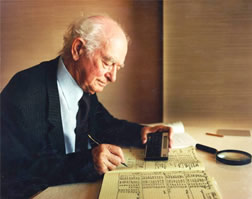Linus Pauling lectures on Vitamin C and Heart Disease
August 13, 1993
By Michael Wooldridge, MAWooldridge@lbl.gov
One of the great scientific mavericks of this century spoke at LBL August 10, 1993 at a special seminar hosted by the Life Sciences Division's Lipoprotein and Atherosclerosis Group. Linus Pauling, two-time Nobel laureate and the world's foremost vitamin C proponent, entertained an overflow crowd in the Bldg. 66 auditorium with a talk on Vitamin C and Heart Disease.
The lively 92-year-old first gave a candid history of how he came to take up the vitamin C cause. He was introduced to the subject by biochemist Irwin Stone in 1966. Five years later, he would pen "Vitamin C and the Common Cold," and then boldly go on to champion vitamin C as a fighter of more serious diseases such as cancer.
According to Pauling, the vitamin's versatility in illness prevention arises from its role in the manufacture of collagen, the protein that gives shape to connective tissues and strength to skin and blood vessels.
 One of the great misfortunes of human evolution, Pauling explained, was when
our human ancestors lost their ability to manufacture vitamin C. Pauling thinks
the trait was probably discarded at a time when our ancestors had a diet of
vitamin-rich plants and didn't need to produce the vitamin themselves. This left
today's primates (including humans) as one of the few groups of animals that
must get the vitamin through the diet.
One of the great misfortunes of human evolution, Pauling explained, was when
our human ancestors lost their ability to manufacture vitamin C. Pauling thinks
the trait was probably discarded at a time when our ancestors had a diet of
vitamin-rich plants and didn't need to produce the vitamin themselves. This left
today's primates (including humans) as one of the few groups of animals that
must get the vitamin through the diet.
Ever since proto-humans moved out of fruit-and-vegetable-rich habitats, Pauling said, they have suffered great deficiencies of vitamin C. Pauling has forthrightly recommended that people make up for this deficiency with daily doses of vitamin C much greater than the 60 mg generally recommended.
He said our vitamin C consumption should be on par with what other animals produce by themselves, typically 10-12 grams a day. Pauling practices what he preaches, having gradually upped his daily doses of vitamin C from 3 grams in the 1960s to a hefty 18 grams today.
Pauling went on to discuss vitamin C's connection with lipoprotein-a, a substance whose levels in the blood have been linked to cardiovascular disease. Lipoprotein-a is also a major component of the plaques found in the blood vessels of atherosclerosis patients.
Pauling has published studies asserting that lipoprotein-a is a surrogate for vitamin C, serving to strengthen blood vessel walls in the absence of adequate amounts of the vitamin in the diet. In the lecture, Pauling noted that animals which, unlike humans, manufacture their vitamin C and have much higher levels of the vitamin in their bodies, have very little lipoprotein-a in their blood.
Pauling is convinced that doses of vitamin C can help prevent the onset of cardiovascular disease, inhibiting the formation of disease-promoting lesions on blood vessel walls and perhaps decreasing the production of lipoprotein-a in the blood. Vitamin C's link to healthy blood vessels, Pauling said, is further supported by studies of scurvy, the disease caused by vitamin C deficiency. Fifty percent of patients who die of scurvy, he said, do so because of ruptured blood vessels.
Pauling won his first Nobel Prize in Chemistry in 1954 for using quantum mechanics to elucidate the nature of chemical bonds. He garnered a Nobel Peace Prize in 1962 for his efforts to stem nuclear weapons proliferation.
The scientist founded the Linus Pauling Institute in Palo Alto, where research on vitamin C and other nutrients continues today. He currently resides in Big Sur.